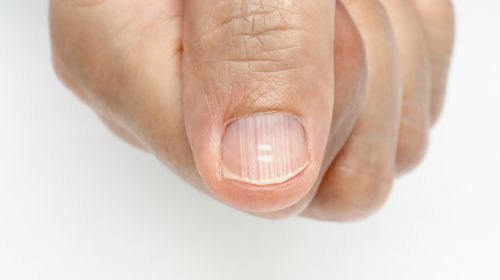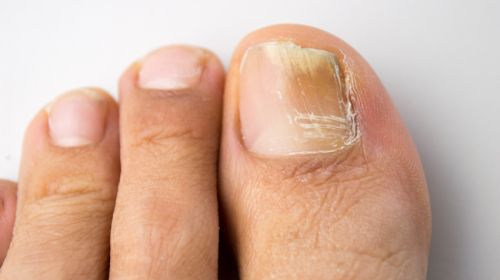Nail discoloration (chromonychia) refers to deviations in the color of toenails or fingernails from their natural coloring. If the nail plate is discolored, it is worth investigating the cause – because the nails can reveal a lot about your own health.
- © Kay A/peopleimages.com – stock.adobe.com
Quick Overview: Nail Discoloration
Normal nails: Healthy nails are translucent and have varying degrees of pink coloring. Depending on skin type, nail color also varies from person to person.
Causes: There are numerous triggers for discolored fingernails and toenails, from nutrient deficiency to nail fungus to underlying heart diseases, for example.
Diagnosis: A visual diagnosis is usually enough for experts. In cases of doubt, a laboratory test or biopsy can be carried out.
Therapy: Treatment depends on the severity and cause of the nail discoloration.
Article contents at a glance:
Normal color of nails
Fingernails and toenails are horny plates that are formed by specialized tissue in the skin. Skin diseases can therefore generally also affect the nails. Like skin, nails contain the pigment melanin, the concentration of which determines the natural nail color.
Normal nails have a light pink tint and are translucent. As with skin, the exact color depends on the respective skin type and can be lighter or darker. Discoloration of the nails is often white, gray or black, but can also take on almost any color from the color spectrum. They are often accompanied by a structural change in the nails.
How are nails structured?
The majority of a nail is firmly attached to the underlying nail bed. They only naturally separate at the tip of the finger or toe. The nail plate, which begins above the nail moon, is visible externally. This marks the transition to the inner part of the nail – the growth zone (nail matrix) and nail root lie under the skin.
Causes of discolored nails
Nail discoloration can occur due to both external and internal influences. Possible causes include, for example, nail fungus, psoriasis or a certain deficiency of vitamins and minerals. Nail injuries caused by incorrect manicures can also lead to discoloration.
The causes of nail discoloration are usually presented in order of color to make diagnosis easier. Since nails grow at a rate of around 0.5 to 1 mm per week, discoloration does not always indicate a current illness, but can also be the result of a previous disorder in the course of nail formation.
If in doubt, those affected should seek help from a doctor.
White nail discoloration (leukonychia)
Injury: local injury to the nail leads to whitish spots on the nails
Infection: An infection with fever during the formation of the affected nail section can cause whitish horizontal stripes
Liver cirrhosis: the nails are reminiscent of the color of frosted glass
Anemia (anemia): In addition to pale nails, fatigue and weakness are typical
Poisoning: Exposure to substances such as saltpeter solution, nitrite solution, thallium or lead
Nails are yellow in color
Nail polish: A result of nail hardeners or nail polishes
Nail fungus: yellowish to brownish discoloration and brittle nails are typical
Psoriasis: light brown to yellowish oil spots under the nails are typical
Medicines: Side effects of medication (see package leaflet)
Hormones: Hormonal changes during puberty or menopause
Jaundice (jaundice)
Yellow nail syndrome: Rare disease characterized by thickening and yellowing of the nails, lymphedema and chronic respiratory diseases (scleronychia syndrome)
Nails are colored green
Follow certain nail polishes
Infection with the bacterium Pseudomonas aeruginosa (Green Nail Syndrome)
fungal infection
Blue to blue-gray nail discoloration
Red to purple nail discoloration
Blood sponge (angioma)
benign tumors of cartilage or nerve tissue
Autoimmune diseases (e.g. rheumatoid arthritis, lupus erythematosus)
Porphyria (iron metabolism disorder)
Heart failure (heart failure)
Blood thinning medications (such as warfarin, heparin)
Nails turn black
Bleeding
increased formation of skin pigment (melanin)
skin cancer located under the nail (melanoma)
Bacterial or fungal infection
Diagnosis: Search for triggers for nail discoloration
As a rule, the dermatologist can determine the cause of the nail change based on the color and possible structural changes of the nail. Many diseases lead to such typical nail changes on the fingers or toes that professionals can get clues about the trigger just from their trained eye.
This visual diagnosis is supplemented by the medical history as well as smears if an infestation with bacteria or fungi is suspected and the taking of tissue samples (biopsy). These are checked for changes that occur in benign or malignant tumors such as skin cancer.
If there is suspicion of an underlying disease such as liver cirrhosis or heart failure, further diagnostic measures will be initiated.
This helps against discolored nails
Treatment for nail discoloration depends on the cause. Triggering factors (e.g. incorrect nail care or certain nail polishes) should be avoided if possible. To prevent color changes caused by nail polish, a colorless base coat should always be applied first.
Infections caused by bacteria or fungi are treated with antibiotics and antimycotics (antifungal agents). Internal diseases such as heart failure are treated specifically. Nail discoloration then improves as a result of general therapy for the underlying disease.
Discoloration of the fingernails and toenails can be harmless and primarily be a cosmetic problem, for example white spots after minor injuries, such as those that can occur when nails are trimmed improperly.
The use of special antifungal agents has proven to be effective for nail fungus. These can be used externally (e.g. in the form of nail polishes or tinctures) or, if nail fungus is more advanced, internally (tablets). The treatment should last long enough to treat the fungal infection successfully and sustainably.


